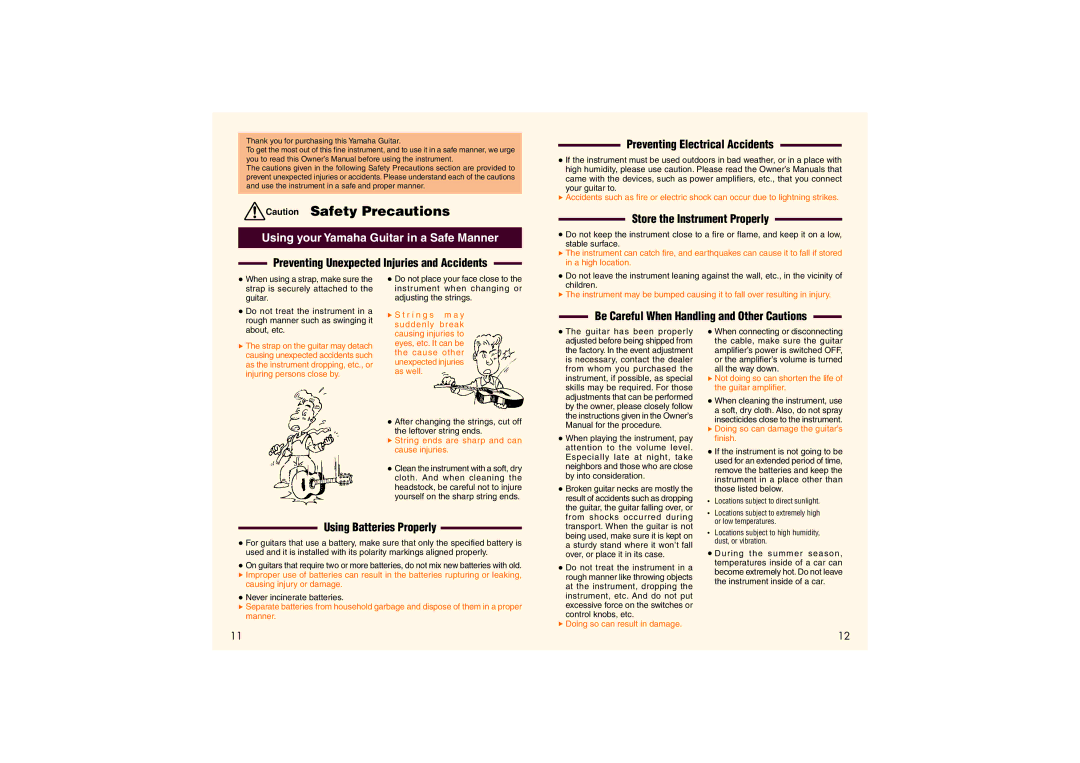
Thank you for purchasing this Yamaha Guitar.
To get the most out of this fine instrument, and to use it in a safe manner, we urge you to read this Owner’s Manual before using the instrument.
The cautions given in the following Safety Precautions section are provided to prevent unexpected injuries or accidents. Please understand each of the cautions and use the instrument in a safe and proper manner.
![]() Caution Safety Precautions
Caution Safety Precautions
Using your Yamaha Guitar in a Safe Manner
Preventing Unexpected Injuries and Accidents
Preventing Electrical Accidents
•If the instrument must be used outdoors in bad weather, or in a place with high humidity, please use caution. Please read the Owner’s Manuals that
came with the devices, such as power amplifiers, etc., that you connect your guitar to.
>Accidents such as fire or electric shock can occur due to lightning strikes.
Store the Instrument Properly
•Do not keep the instrument close to a fire or flame, and keep it on a low,
stable surface.
>The instrument can catch fire, and earthquakes can cause it to fall if stored in a high location.
• When using a strap, make sure the |
strap is securely attached to the |
guitar. |
• Do not treat the instrument in a |
rough manner such as swinging it |
•Do not place your face close to the instrument when changing or adjusting the strings.
> S t r i n g s m a y suddenly break
•Do not leave the instrument leaning against the wall, etc., in the vicinity of
children.
>The instrument may be bumped causing it to fall over resulting in injury.
Be Careful When Handling and Other Cautions
about, etc. |
>The strap on the guitar may detach causing unexpected accidents such as the instrument dropping, etc., or injuring persons close by.
causing injuries to eyes, etc. It can be the cause other unexpected injuries as well.
•After changing the strings, cut off
the leftover string ends.
>String ends are sharp and can cause injuries.
•Clean the instrument with a soft, dry cloth. And when cleaning the headstock, be careful not to injure yourself on the sharp string ends.
• The guitar has been properly |
adjusted before being shipped from |
the factory. In the event adjustment |
is necessary, contact the dealer |
from whom you purchased the |
instrument, if possible, as special |
skills may be required. For those |
adjustments that can be performed |
by the owner, please closely follow |
the instructions given in the Owner’s |
Manual for the procedure. |
• When playing the instrument, pay |
attention to the volume level. |
Especially late at night, take |
neighbors and those who are close |
by into consideration. |
• Broken guitar necks are mostly the |
result of accidents such as dropping |
the guitar, the guitar falling over, or |
from shocks occurred during |
•When connecting or disconnecting the cable, make sure the guitar amplifier’s power is switched OFF,
or the amplifier’s volume is turned all the way down.
>Not doing so can shorten the life of the guitar amplifier.
•When cleaning the instrument, use a soft, dry cloth. Also, do not spray
insecticides close to the instrument.
>Doing so can damage the guitar’s finish.
• If the instrument is not going to be |
used for an extended period of time, |
remove the batteries and keep the |
instrument in a place other than |
those listed below. |
• Locations subject to direct sunlight. |
• Locations subject to extremely high |
or low temperatures. |
Using Batteries Properly
•For guitars that use a battery, make sure that only the specified battery is used and it is installed with its polarity markings aligned properly.
•On guitars that require two or more batteries, do not mix new batteries with old. > Improper use of batteries can result in the batteries rupturing or leaking,
causing injury or damage.
•Never incinerate batteries.
>Separate batteries from household garbage and dispose of them in a proper manner.
transport. When the guitar is not |
being used, make sure it is kept on |
a sturdy stand where it won’t fall |
over, or place it in its case. |
• Do not treat the instrument in a |
rough manner like throwing objects |
at the instrument, dropping the |
instrument, etc. And do not put |
excessive force on the switches or |
control knobs, etc.
>Doing so can result in damage.
• Locations subject to high humidity, |
dust, or vibration. |
• During the summer season, |
temperatures inside of a car can |
become extremely hot. Do not leave |
the instrument inside of a car. |
11 | 12 |
